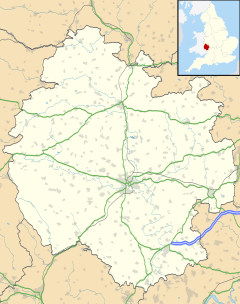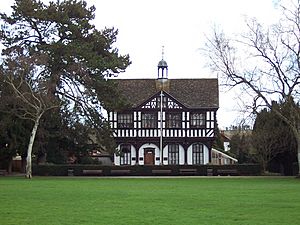Leominster facts for kids
Quick facts for kids Leominster |
|
|---|---|
 Leominster Priory |
|
| Population | 11,691 |
| OS grid reference | SO496591 |
| Civil parish |
|
| Unitary authority | |
| Ceremonial county | |
| Region | |
| Country | England |
| Sovereign state | United Kingdom |
| Post town | LEOMINSTER |
| Postcode district | HR6 |
| Dialling code | 01568 |
| Police | West Mercia |
| Fire | Hereford and Worcester |
| Ambulance | West Midlands |
| EU Parliament | West Midlands |
| UK Parliament |
|
Leominster ( LEM-stər) is a market town in Herefordshire, England, at the confluence of the River Lugg and its tributary the River Kenwater. The town is 12 miles (19 km) north of Hereford and 7 miles south of Ludlow in Shropshire. With a population of 11,700, Leominster is the largest of the five towns (Leominster, Ross-on-Wye, Ledbury, Bromyard and Kington) in the county.
From 1974 to 1996, Leominster was the administrative centre for the former local government district of Leominster.
Contents
Toponymy
The town takes its name from a minster, that is a community of clergy in the district of Lene or Leon, probably in turn from an Old Welsh root lei to flow. Contrary to certain reports, the name has nothing to do with Leofric, an 11th-century Earl of Mercia (most famous for being the miserly husband of Lady Godiva). The Welsh name for Leominster, still used today by a few on the Welsh side of the nearby border, is Llanllieni.
History

During the Early Middle Ages, Leominster was home to Æthelmod of Leominster, an English saint known to history mainly through the hagiography of the Secgan Manuscript. He is reputedly buried in Leominster.
According to the Anglo-Saxon Chronicle, a raid by Gruffudd ap Llywelyn on Leominster in 1052 resulted in the Battle of Llanllieni, between the Welsh and a combined force of Normans (mercenaries) and English Saxons.
Henry II bestowed the minster and its estates on Reading Abbey, which founded a priory at Leominster in 1121, although there was one here from Saxon times. Its Priory Church of St. Peter and St. Paul, which now serves as the parish church, is the remaining part of this 12th-century Benedictine monastery. Quatrefoil piers were inserted between 1872–79 by Sir George Gilbert Scott.
The priory was ransacked by the Welsh forces of Owain Glyndŵr after their victory at the Battle of Bryn Glas near Pilleth in 1402, along with several local manor houses.
Investigations to the north of the priory in 2005 located the position of the cloister, although most of the stone had been stolen following the Dissolution. Discarded animal bones found on the site when submitted to carbon dating showed that the area was occupied in the 7th century. This agrees with the date of 660 CE associated with the founding myth, which suggests a Christian community was established here by a monk, St. Edfrid, from Northumberland.
Leominster is also the historical home of Ryeland sheep, a breed once famed for its "Lemster" [sic] wool, known as 'Lemster ore'. This wool was prized above all other English wool in trade with the continent of Europe in the Middle Ages. It was the income and prosperity from this wool trade that established the town and the minster and attracted the envy of the Welsh and other regions.
From approximately 1748 to 1754, Pinsley Mill in Leominster was home to one of the Paul-Wyatt cotton mills, the first four cotton mills in the world, employing the spinning machines of Lewis Paul and John Wyatt. The mill was financed by Lancashire native Daniel Bourn, and was partly owned by other men from Lancashire. Bourn introduced his own version of the carding engine to work at this mill, and of the four Paul-Wyatt mills, it may have been the most successful, as shortly after the fire that destroyed the mill, it was reported that the cotton works "had been viewed with great pleasure and admiration by travellers and all who had seen them."
One of the last ordeals by ducking stool took place in Leominster in 1809, with Jenny Pipes as the final incumbent. The ducking stool is on public display in Leominster Priory; a mechanised depiction of it is featured on the town clock.
Climate
As with all towns in the United Kingdom, Leominster has a maritime climate, with mild winters and summers. The data below is from a weather station in Preston Wynne, a village about 10 miles South East of Leominster.
| Climate data for Preston Wynne, elevation 84 metres (276 ft), 1971–2000 | |||||||||||||
|---|---|---|---|---|---|---|---|---|---|---|---|---|---|
| Month | Jan | Feb | Mar | Apr | May | Jun | Jul | Aug | Sep | Oct | Nov | Dec | Year |
| Average high °C (°F) | 6.9 (44.4) |
7.3 (45.1) |
9.9 (49.8) |
12.3 (54.1) |
15.9 (60.6) |
18.7 (65.7) |
21.5 (70.7) |
21.2 (70.2) |
18.0 (64.4) |
13.9 (57.0) |
10.0 (50.0) |
7.8 (46.0) |
13.6 (56.5) |
| Average low °C (°F) | 1.1 (34.0) |
0.9 (33.6) |
2.4 (36.3) |
3.3 (37.9) |
6.0 (42.8) |
8.7 (47.7) |
10.8 (51.4) |
10.6 (51.1) |
8.6 (47.5) |
6.0 (42.8) |
3.0 (37.4) |
1.7 (35.1) |
5.3 (41.5) |
| Source: YR.NO | |||||||||||||
Transport
The 4-mile (6.4 km) A49 £9 million bypass opened in November 1988. The town also has a bus station linking it to Hereford and a number of nearby towns and villages.
Railways
Leominster railway station is managed by Transport for Wales who provide services on the Welsh Marches Line. As well as the Shrewsbury and Hereford Railway
Buses
There are regular buses to Bromyard, Hereford, Worcester and Ludlow. As well as an infrequent bus service to Ledbury.
Twin towns
Leominster is twinned with Saverne in France, and Tengeru in Tanzania.
Local attractions
- Croft Castle
- Berrington Hall
- Grange Court, Leominster town centre
- Priory Church, Leominster
- Monkland Cheese dairy
- Hampton Court
- Stockton Bury Gardens
Notable people
- John Ward (24 June 1704 – 30 October 1773) was an English actor and theatre manager. He was the first of the Kemble family theatrical dynasty and the first recorded performer of a Shakespearian play in Stratford-upon-Avon, and is also notable as the author of the two earliest surviving prompt books of Shakespeare's Hamlet, which reveal how the play was performed in eighteenth century England and also throw light on earlier practice. Upon Ward's retirement, Roger Kemble took on his first management position by taking over the management of the theatre at Leominster in 1766. He formed a traveling theatrical company soon after his marriage to Sarah Ward, and subsequently she and their children toured with the company for the next fifteen years. Five of Kemble's children and many of his grandchildren became famous actors. The oldest of their twelve children, Sarah Siddons, became the most famous.
- Saint Cuthfleda was the abbess of Leominster nunnery and the patroness of the region. She was known for her holiness and her chaste life.
- Æthelmod of Leominster Anglo-Saxon Saint
- Leofric, Earl of Mercia and his wife Godgifu Lady Godiva – are commemorated as benefactors of the monastery at Leominster
- John Abel (1578/9-1675), an English carpenter and mason, granted the title of 'King's Carpenter', who was responsible for several notable structures in the ornamented half-timbered construction, notably the market house known as Grange Court (1633) in Leominster, which originally stood in Broad Street, but was rebuilt in 1855 near to the Priory Church. It is widely regarded as one of Abel's finest works.
- John Scarlett Davis (1804–1845), artist, was born at 2 High Street. A number of his works are in Leominster Museum.
- Arthur Peppercorn (1889–1951), locomotive designer
- Jarrod Bowen (1996-), footballer for West Ham United
See also
 In Spanish: Leominster para niños
In Spanish: Leominster para niños



